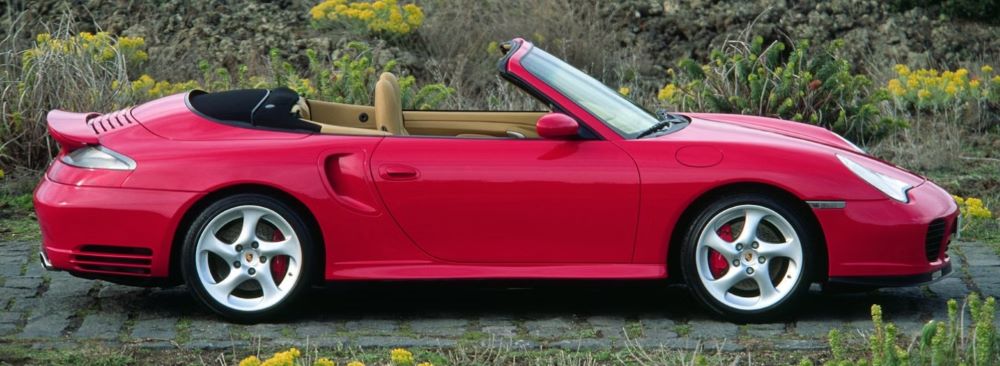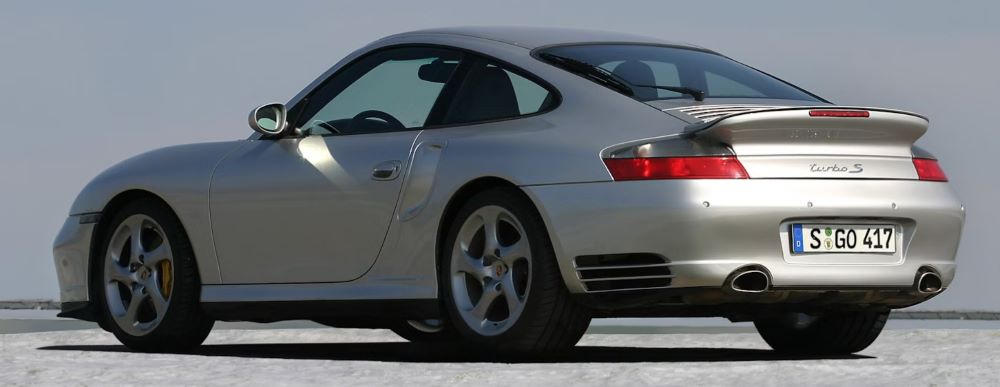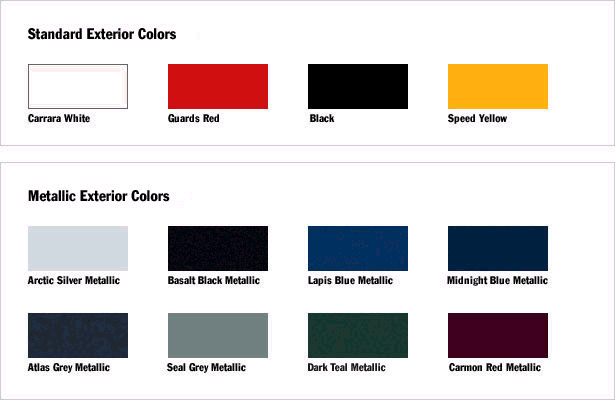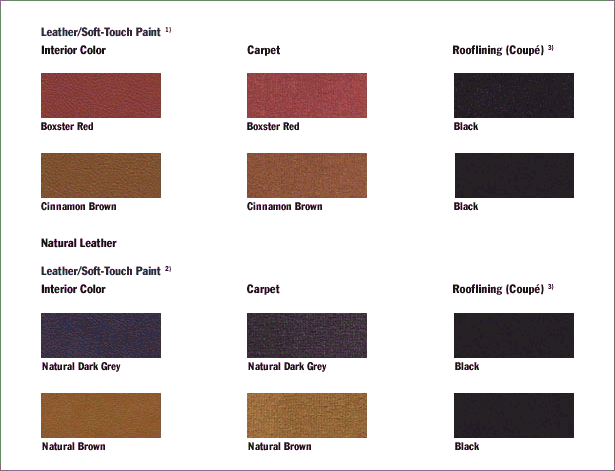
The 2006 Porsche 911 Turbo is more than a car – it is a masterpiece of automotive technology. Compelling evidence of just how powerful and uncompromising the 911 concept can be. The turbocharged “flat-six” combines unparalleled power from its 415 hp engine. Acceleration is phenomenal yet inherently secure, delivering 0–62 mph (100 km/h) in as little as 4.2 seconds with manual gearbox. Key technologies include Porsche Stability Management, permanent all-wheel drive, VarioCam Plus and optional Tiptronic S.
The first sports car ever to bear the Porsche name was a roadster. More than five decades later, Porsche offers the latest, and greatest evolution: the new 911 Turbo Cabriolet. It is, by all accounts, the most refined and technically advanced convertible we have ever built – satisfying a driver’s passion for speed, precision and the pure joy of the open road. The 911 Turbo Cabriolet’s power and uncompromising performance are identical to that of the 911 Turbo Coupé. But its power to stir your senses and connect you with your surroundings is in a class by itself, elevating the allure of open-topped driving to an exhilarating new level.

Engine – Performance
Mounted in its time-honored place behind the rear axle, a race-proven boxer engine lies at the heart of the 911 Turbo’s aggressive, all-out assault on sports car benchmarks. The new 24-valve, 3.6-liter design, derived from our GT1 which won the Le Mans race, delivers unbridled performance previously reserved for the race track. Advanced cross-flow water cooling allocates a separate circuit for each cylinder and head, allowing the engine’s 415 hard-charging horses to keep their cool. Dual exhaust-driven turbochargers lend more power and punch, churning out 415 lb-ft of earth moving torque.
The 911 Turbo engine is based on the water-cooled “flat-six” used in the Le Mans winning 911 GT1. Equipped with twin exhaust-gas turbochargers, this 3.6-liter engine develops 415 hp at 6,000 rpm. Touch the throttle, and the engine responds with unprecedented immediacy and precision. Another key technology is VarioCam Plus, which combines variable valve timing and lift. Maximum torque of 415 lb-ft is available from 2,700 to 4,600 rpm, ensuring exceptional flexibility and seemingly endless reserves of energy. The overall result is a fluidity of acceleration and natural finesse normally associated with much larger eight or 12-cylinder engines
The 911 Turbo Cabriolet’s outstanding dynamic performance is unmistakably 911 Turbo. The only difference is that cruising through beautiful scenery now becomes an even more direct and stimulating experience. Despite the low weight of this convertible, the wide body ensures exemplary rigidity. In addition, the 911 Turbo Cabriolet also possesses one of the best brake systems ever to be installed in a standard production vehicle
The Porsche 911 Turbo will undoubtedly provide a driving experience that is one of the most compelling ever created. The origin of that experience is the proven Porsche philosophy of continuous evolution and refinement; not only in terms of outright performance, but also when it comes to personalization. On today’s 911 Turbo, the options available include a comprehensive engine upgrade. Key modifications include larger compressor and turbine units together with uprated intercoolers and an increase in boost pressure from 0.8 to 0.9 bar. The finished product is a jump in outright power from 415 to 444 hp. Maximum torque is raised to a remarkable 457 lb-ft, enabling rapid acceleration and enhanced flexibility over the entire engine speed range. Given the extensive nature of the modifications to the engine and gearbox, this particular package is only available as a factory installed option.
Transmission Tiptronic S.
The full privileges of driving a turbocharged Porsche can be enjoyed with the fun and immediacy of manual shifting or the convenience of an automatic transmission. Simply choose the automatic mode or manually change gears using rocker buttons on the steering wheel. Engineered to match the Turbo’s awesome torque output, the revolutionary Tiptronic S transmission allows you the freedom to choose a style of driving that matches your mood.
The 911 Turbo is also available with the Tiptronic S transmission. This versatile system combines fully automatic five-speed operation with the option of manual control. In automatic mode, the system can choose from five different gearshift patterns. These range from maximum fuel economy for everyday road use, to maximum sports performance. While you are driving, Tiptronic S monitors your inputs as well as the terrain and selects the most natural pattern. Within a short time, you’ll develop a feel for the system and be able to alter the gearshift points by adjusting your throttle inputs.
Tiptronic S is particularly effective when exploring the car’s performance. With rapid gearshifts and minimal interruption in drive, the system offers a fast and fluid drive. The immediate response is comparable with that of a Porsche manual gearbox. Other intelligent functions include a warm-up program, active selection of the “Sport” gearshift pattern, automatic suppression of lift-off upshifts and mid-corner gear changes, enhanced engine braking, and automatic upshifts under braking in difficult road conditions.
For full manual control, simply slot the gear selector into manual mode and use the gearshift controls on the steering wheel. Press up to change up, and down to change down. The response from the gearbox is instantaneous, with virtually no interruption in drive. A manual override is also available when driving in automatic mode. This function is particularly useful for short bursts of acceleration or enhanced engine braking. If no further manual inputs are made within a period of eight seconds, the system reverts to automatic mode. The current gear selection is displayed on the instrument panel using the same symbols found on the gear selector gate
The 911 Turbo comes with smooth leather upholstery in a choice of four interior colors. The leather trim extends from the dashboard and seats to the doors and rear side panels. The rooflining in the Coupé is made from elegant Alcantara in your chosen interior color. The Cabriolet version is available with a choice of three soft top colors, each with a black interior lining. Luxurious pile carpet is combined with a range of aluminum features to enhance the overall ambience of elegance and athleticism.
The majority of synthetic surfaces have a soft-touch paint finish, also in your chosen interior color. A retractable cupholder beneath the center air vent offers a secure location for two drink containers. An orientation lighting system provides subtle illumination of the ignition lock, gear lever and door-release handles. Both the luggage compartment and engine bay can be opened from the cockpit using a simple push-button release. The luggage compartment at the front offers 3.5 cu ft (100 liters) of cargo space and can be opened using the key remote. The soft top mechanism on the Cabriolet is fully automatic and is also operated using a single push-button control
The 911 Turbo Cabriolet is first and foremost a Porsche. That means it is powerful, agile, thoroughly refined and wonderfully comfortable. But the 911 Turbo Cabriolet is also a Porsche that can change its personality with the weather. When the sun is out, simply push a single button on the center console. The side windows descend, a “Z” shape fold to ensure the inside of the top remains well protected at all times, and stows automatically in just 20 seconds.
That same button can also provide safe harbor when the weather turns bad. The full headliner improves thermal insulation and reduces noise. Plus, the rear glass window is heated to maintain rearward visibility in poor conditions. A hardtop made of high-strength aluminum comes standard with every 911 Turbo Cabriolet. Given the enormous capability of the 911 Turbo, it was essential that we develop a passive safety concept that was equal to the performance of the car. The result is a convertible that is not only one of the most powerful in the world, but also one of the most secure.
The 911 Turbo is clearly designed for a more intuitive driving experience. All information is logically presented, while every control is precisely where you’d expect to find it.
The instruments are arranged in the classic Porsche configuration of five round dials. The center instrument contains the analog rev counter with “turbo” logo plus two digital odometers (total miles and trip). The dial to the left contains the analog and digital speedometers, while the dial on the right has a digital clock. The lower portion of the center instrument contains a dot-matrix display for the standard on-board computer. A range of data can be presented here, including boost pressure, oil level, average fuel economy, average speed, range and external temperature. The display can also be used for a number of functions on the standard Porsche Communication Management (PCM) system.
The high-beam and direction indicator lights are neatly displayed within the center rev counter. All other warning lights are elegantly arranged in a row beneath the instrument cluster. The brightness and contrast on all digital instruments are automatically adjusted as ambient light conditions change and the glass on each dial is specially angled to avoid unwanted reflection. The result is an integrated information source that remains clearly visible at all times.
Both front seats of the 911 Turbo offer full electric adjustment – height, fore/aft, backrest and tilt – as well as excellent lateral support. The driver memory function conveniently stores up to two sets of seat preferences. Additional sets of preferences can be stored in each of the two key remotes and automatically selected upon entering the car. Leather sports seats are available as a no-cost options on both 911 Turbo models.
Despite its lightweight construction, the 911 Turbo Cabriolet enjoys exceptional rigidity for a two-plus-two convertible, allowing only minimal flexing on uneven surfaces. In the event of a rollover, the occupants are protected by a combination of reinforced A-pillars at the front of the car as well as an automatically deployed system of spring-loaded aluminum supplemental safety bars that are discreetly located behind the rear seats. A sensor monitors the momentum of the body as well as the forces of acceleration and gravity. If the car begins to roll, the system responds by deploying the bars instantaneously. Interior safety equipment includes full-size front airbags and Porsche Side Impact Protection (POSIP).
The standard POSIP package has twin side airbags backed by energy-absorbing door panels and is a unique feature in this type of car. The generous 30-liter side airbags offer vital protection for the head and upper torso – even when the windows are fully open. Together, these systems offer a standard of safety that is one of the essential hallmarks of Porsche engineering.
The 911 Turbo uses a cross-flow cooling system with fully integrated coolant management. This highly effective technology is specifically designed to ensure optimum heat dispersal on all six cylinders. All coolant passages are integrated into the engine castings, thereby eliminating the need for external hoses. Cross-flow cooling provides a direct flow of coolant to each of the cylinders, ensuring that the coolant has not been pre-warmed. Originally developed for Formula One, this solution offers exceptional reliability as well as minimal maintenance requirements. The system also includes a dedicated oil/water heat exchanger providing direct engine-oil cooling. Heat is discharged via twin radiator modules located ahead of the front wheels and a central radiator in front
The 911 Turbo engine features the classic Porsche arrangement of two “horizontally opposed” banks of three cylinders. This “flat-six” configuration combines excellent cylinder charging and torque characteristics with outstanding balance and refinement. The alloy crankcase is made from two separate castings (left and right) while the crankshaft runs in eight main bearings. The forged connecting rods are combined with forged aluminum pistons to achieve optimum durability and a free-revving response.
The piston crowns are precision-cooled using a special oil-jet system. The aluminum liners have a Nikasil coating which helps to minimize friction while extending the life of the engine The cylinder heads are made from an extremely temperature-resistant lightweight alloy. Each cylinder has two inlet and two outlet valves arranged in a “V” configuration. In order to compensate for the high pressures generated in a turbocharged engine, each of the engine’s 24 valves has a dual-spring closing mechanism. The intake valves are actuated with the aid of VarioCam Plus, which combines two-stage valve lift (low and high) with continuously variable camshaft adjustment. The benefits are not only greater power and torque, but also lower fuel consumption and emissions
The 911 Turbo engine uses “dry-sump” lubrication to achieve continuous oil delivery under even the most extreme road and track conditions. This race-proven technology uses a pair of pumps on each of the cylinder heads together with a single pump in the crankcase to “scavenge” oil back to an external tank. The oil is then defoamed before being supplied to the various lubrication points throughout the engine by means of a dedicated oil-feed pump. All new vehicles are supplied pre-filled with 11 liters of Mobil 1 high-performance synthetic oil. The superb lubrication properties of this high-quality oil ensure reliable starts even in sub-zero conditions. Other benefits include optimum protection for engine components as well as greater fuel economy – even in competition use. The oil level can be monitored from the comfort of the cockpit via the standard on-board computer. This solution is not only cleaner and more convenient, it is also more accurate than a conventional dipstick
PMC Standard equipment on the 911 Turbo includes the latest version of Porsche Communication Management (PCM). This comprehensive communications package has been designed with great attention to detail to ensure that it is as user-friendly as possible. Key features include a high-resolution 5.8-inch color display with 16:9 screen ratio, an integrated CD drive, as well as an intuitive navigation module.
User Interface
Selected information, such as current radio station or CD track number, is displayed in the dot-matrix field in the instrument cluster. The PCM terminal is logically laid out for more intuitive operation. The high-resolution display provides a useful overview of all essential information. A rotary control serves as both on/off switch and volume adjuster, while a second rotary control with integrated ‘enter’ button is used to navigate through the various menus.
An integrated CD drive is located centrally above the display and can be used for both navigation CD-ROMs and music CDs.
GPS Navigation
One of the most important features of PCM is the satellite-based GPS navigation system with integrated antenna. To plan a route, simply insert the corresponding navigation CD and enter the name or address of your destination. PCM then determines your current position using GPS, and stores the optimum route together with a range of detour options into memory. At this point, PCM no longer requires the navigation CD, leaving you free to enjoy your favorite music CDs from the CD storage included with the PCM package. Route guidance instructions are then blended in over current audio output as needed. When specifying a destination, you can also choose from a range of route criteria to determine the types of road you wish to use. During your journey, all relevant data such as position, direction and vehicle speed are automatically processed by the system.
On-Board Computer
The PCM computer can supply a wide range of information, including average fuel consumption, average speed, and journey time. The computer is operated using a separate control stalk on the steering column, and can also display key information in the standard dot-matrix field at the center of the instrument cluster. With a choice of output in kilometers or miles, as well as support for multiple languages and international time zones, PCM is equipped for every corner of the world.
Audio System
PCM now features an integrated CD drive. After planning your route with a navigation CD, the drive is free for your favorite music CD. Radio functionality includes 20 FM and 20 AM presets, Dynamic AutoStore and RDS two-tuner frequency diversity. The PCM audio system is fully compatible with the Porsche Hi-Fi Sound Package, the six-disc CD autochanger and the enhanced digital audio of the Bose® Sound System.
The standard Bose® Sound System delivers lifelike digital stereo to every seat in the car. System electronics include a 100-Watt switching amplifier with five additional 25-Watt linear amps. Data is exchanged via the new fiber optic-based Media Orientated System Transport (MOST®) bus system, ensuring a quality of sound that is worthy of your Porsche. One of the key features of the Bose Sound System is AudioPilot™ Noise Compensation Technology. Using a microphone in the dashboard, AudioPilot monitors the sound in the cockpit and automatically compensates for any ambient noise. Another major feature supported by the new MOST bus technology is digital signal processing. This powerful amplification circuitry enhances low-volume passages – for example in classical music recordings – while automatically correcting any subjective loss of bass. Sound is delivered through a series of 12 speakers in the 911 Turbo Coupé – one more than in the Cabriolet version. Both models come with two dashboard modules, each with one tweeter and one mid-range speaker. These are supported by a pair of low-mid-range speakers mounted in 5.5-liter door enclosures. An additional set of tweeters and mid-range speakers can be found in each of the rear side panels. The 911 Turbo Coupé has an additional pair of low-range speakers in a 13.8-liter anti-vibration enclosure which is neatly located behind the rear seats. On the 911 Turbo Cabriolet, those speakers are replaced by a discreet bass enclosure in the front passenger footwell
The front and rear suspensions provide consistency and comfort in even the most extreme road conditions. At the front of the car, we’ve combined Porsche-optimized McPherson struts with a system of longitudinal and lateral links. This configuration provides optimum control of wheel location for outstanding stability and handling. The rear suspension uses a subframe-mounted multi-link geometry featuring Porsche LSA (Light, Stable, Agile) technology. This race-proven solution enhances the car’s exceptional dynamics, virtually eliminating understeer in high-speed corners. The aluminum-based subframe helps to minimize noise and vibration from the road while strengthening the car’s structural rigidity. Handling is enhanced on both models (Coupé and Cabriolet) with the aid of customized spring and damper settings
Wheels, The 911 Turbo comes standard with 18-inch Turbo II wheels –18 x 8 at the front and 18 x 11 at the rear. The Turbo II wheel has a hollow-spoke construction offering a total weight saving of about 6.7 lbs (3 kg) of unsprung weight per wheel over conventional designs. Grip is assured through the combination of 225/40 ZR 18 tires at the front of the car and 295/30 ZR 18 at the rear
The hydraulically assisted steering is sensitive and precise with feedback from the road. Maneuverability is natural and fluent, aided by the modest turning circle and relatively short lock-to-lock travel. While parking and urban driving require only minimal driver effort, the feel at higher speeds is comparable with that of a motorsport car.
Longer service intervals from a more intelligent use of materials and resources mean minimized maintenance costs. Over the past 25 years, we’ve continually extended the service intervals on our cars, while reducing the maintenance requirements. On the 911 Turbo, the figures say it all: change engine oil every 12,000 miles; spark plugs, oil filter and air filter every 24,000 miles; and fuel filter every 48,000 miles. Most remarkable of all, the original coolant charge is good for the life of the car.

Porsche 911 Turbo S (type 996)
The model range was expanded in model year 2005 with the 911 Turbo S. This vehicle was available as a Coupé and as a Cabriolet. With an output of 450 PS, the Turbo S delivered a total of 30 PS more than the standard 911 Turbo.






